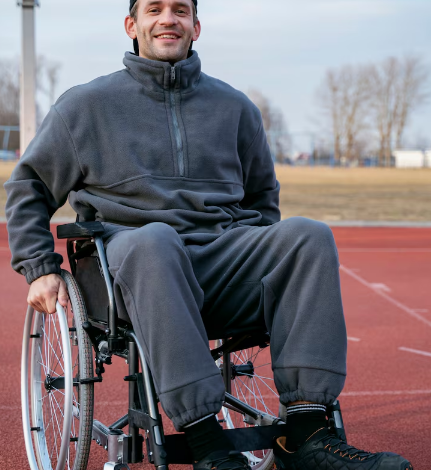Types of Muscular Dystrophy You Should Know About

Muscular dystrophy is a group of conditions that make muscles weaker over time. It happens because of changes in genes that are important for keeping our muscles healthy. There are many different kinds of muscular dystrophy, and they can show up at different ages, affecting various muscles. While it can be a lot to take in, knowing about the different types can help us understand the condition better.
Key Takeaways
- Duchenne muscular dystrophy is the most common type, usually starting in early childhood, and it tends to get worse quickly.
- Becker muscular dystrophy is similar to Duchenne but generally milder and progresses more slowly, often appearing later in life.
- Myotonic muscular dystrophy is characterized by muscles having trouble relaxing after use and can affect the heart and breathing.
- Limb-girdle muscular dystrophy typically weakens muscles in the hips and shoulders, with symptoms varying widely in when they start and how they progress.
- Facioscapulohumeral muscular dystrophy often affects facial muscles, shoulders, and upper arms, sometimes progressing unevenly on one side of the body.
Understanding Duchenne Muscular Dystrophy
The Most Common Form of Muscular Dystrophy
Duchenne muscular dystrophy, often called DMD, is the most frequent type of muscular dystrophy out there. It mainly affects boys, though girls can sometimes carry the gene and show mild symptoms. This condition is caused by a genetic change that affects a protein called dystrophin, which is really important for keeping muscles healthy. When there isn’t enough or any dystrophin, muscles start to break down over time. It’s a progressive disease, meaning it gets worse as time goes on.
Early Childhood Onset and Symptoms
Symptoms of DMD usually pop up pretty early, often before a child turns five. You might notice things like delayed walking, frequent falls, or difficulty getting up from the floor. Kids with DMD might also struggle with running, jumping, or climbing stairs, and they might walk with a bit of a waddle or on their tiptoes. Sometimes, their calf muscles can look bigger than usual, and they might complain of muscle pain or stiffness. Delayed growth and some learning or behavior challenges can also be part of the picture. It’s a lot for parents to deal with, and getting a diagnosis can be tough.
Progression and Complications
As DMD progresses, muscle weakness spreads, making everyday movements harder. Many boys with DMD eventually need a wheelchair, usually by the time they’re around 12 years old. Beyond just walking, the disease can affect other parts of the body too. This includes the heart, leading to a condition called cardiomyopathy where the heart muscle weakens. It can also affect the spine, causing scoliosis (a curve in the spine), which can make breathing problems worse. Breathing itself can become difficult, and some individuals may eventually need a respirator. While there’s no cure yet, proper medical care and support can help manage symptoms and improve quality of life, allowing many to live into adulthood. Learning about Duchenne muscular dystrophy is the first step for many families.
Exploring Becker Muscular Dystrophy
Similarities and Differences with Duchenne
Becker muscular dystrophy (BMD) shares a lot of similarities with its more severe counterpart, Duchenne muscular dystrophy (DMD). Both conditions stem from a lack of or reduced dystrophin, a protein vital for muscle health. This genetic link means the symptoms can look alike initially. However, the key difference lies in the severity and progression rate. BMD generally progresses much more slowly than DMD. While DMD often leads to significant disability by early adolescence, BMD symptoms might not become apparent until the teenage years or even early adulthood. It’s not uncommon for individuals with BMD to live a normal lifespan, though their muscle strength might still be affected. It’s always a good idea to consult with neurology doctors to get a proper diagnosis and understand your specific situation.
Later Onset and Milder Progression
Unlike Duchenne, which typically shows symptoms before age five, Becker muscular dystrophy usually makes its presence known later. Symptoms often begin to appear between the ages of 11 and 25, though some people might not notice issues until their mid-20s or even later. The weakness typically starts in the muscles of the upper legs and hips, and then moves to the shoulders and upper arms. This slower progression means that while muscle weakness is present, it might not impact daily life as dramatically or as quickly as in Duchenne.
Impact on Daily Life
The way Becker muscular dystrophy affects daily life can vary quite a bit from person to person. Some individuals might only experience mild weakness and may not need any walking aids. Others might find they need a cane or other assistive devices as they get older to help with mobility. In some cases, a wheelchair might be necessary later in life, but this is less common and usually occurs much later than with Duchenne. Regular check-ups with healthcare providers are important to manage any potential complications, such as heart issues, which can sometimes occur.
It’s important to remember that while BMD affects muscle strength, it doesn’t necessarily define a person’s entire life. Many individuals lead fulfilling lives, pursuing careers and hobbies, with appropriate support and medical care.
Here’s a quick look at how BMD compares to DMD:
| Feature | Duchenne Muscular Dystrophy (DMD) | Becker Muscular Dystrophy (BMD) |
| Dystrophin Levels | Absent or very low | Reduced |
| Onset of Symptoms | Before age 5 | Ages 11-25 (or later) |
| Progression | Rapid | Slow |
| Severity | Severe | Milder |
| Lifespan Impact | Often shortened | Usually not significantly affected |
Getting a diagnosis and understanding the specific type of muscular dystrophy you or a loved one has is the first step. This allows for tailored management plans, often involving a team of specialists, including those focused on neurology doctors.
Myotonic Muscular Dystrophy: A Closer Look
Delayed Muscle Relaxation
Myotonic Muscular Dystrophy (MMD) is a bit different from other types. The main thing to know is that it affects your muscles’ ability to relax after you use them. Think about shaking someone’s hand – with MMD, your hand might stay clenched for a while afterward. This myotonia, or delayed relaxation, is the hallmark symptom. It can happen in your hands, feet, or even your tongue. It’s not just a minor inconvenience; it can make simple tasks like gripping something or letting go quite challenging.
Affected Body Parts and Symptoms
While the myotonia is the defining feature, MMD can affect a lot of different parts of the body. Often, the muscles in the face and neck are affected early on. This can lead to a rather expressionless face or drooping eyelids. Beyond that, weakness can spread to other muscles, impacting your ability to walk, stand, or even swallow properly. Some people also experience cataracts, which are clouding of the eye lens, and issues with their digestive system, like constipation. It can also mess with your hormones, potentially causing thyroid problems or diabetes.
Potential Heart and Breathing Issues
This is where MMD can get pretty serious. The heart muscle itself can be affected, leading to irregular heart rhythms or a weakened heartbeat. In some cases, people might need a pacemaker or a defibrillator to keep their heart beating normally. Breathing muscles can also weaken over time, which can cause problems, especially when sleeping. It’s not uncommon for people with MMD to experience sleep apnea or other breathing difficulties. Because these issues can be so significant, regular check-ups with a doctor are really important to monitor heart and lung function.
Limb-Girdle Muscular Dystrophy: What to Know
Weakness in Upper Limbs and Hips
Limb-girdle muscular dystrophy, or LGMD, is a group of genetic conditions that primarily affect the muscles closest to your body’s core. This means the muscles in your shoulders, upper arms, hips, and thighs are typically the first ones to show signs of weakness. It’s not uncommon for people with LGMD to notice difficulty with activities like climbing stairs, getting up from a chair, or even just walking. The weakness can spread over time, impacting other muscles as well.
Varied Onset and Progression
One of the things that makes LGMD a bit complex is that it doesn’t have a single, predictable timeline. Symptoms can show up at different ages, sometimes starting in childhood, but often not appearing until adulthood, even as late as age 40. The rate at which the muscle weakness progresses also varies a lot from person to person and even between the different subtypes of LGMD. This variability means that the impact on daily life can differ significantly.
Impact on Mobility
As LGMD progresses, the increasing muscle weakness can really start to limit mobility. Many individuals find they need assistance with everyday movements. Eventually, some people with LGMD may require the use of a wheelchair to maintain their independence and get around. It’s a progressive condition, so managing symptoms and adapting to changes in physical ability is a key part of living with LGMD. Learning about the different forms can help understand the specific challenges associated with this condition.
It’s important to remember that while LGMD causes progressive muscle weakness, the specific muscles affected and the speed of progression can vary greatly. This means that not everyone will experience the same symptoms or the same level of disability.
Facioscapulohumeral Muscular Dystrophy
Facioscapulohumeral muscular dystrophy, often shortened to FSHD, is a condition that affects muscles in the face, shoulders, and upper arms. It’s one of the more common types of muscular dystrophy, and it can show up at different times in life, though it often starts in the teenage years or early adulthood. One of the things that makes FSHD a bit different is that the weakness can be asymmetrical, meaning one side of the body might be more affected than the other. This can lead to some unique challenges and visible signs.
Facial, Shoulder, and Upper Arm Weakness
The name itself gives you a clue about where the weakness typically shows up first: the face (facio-), the shoulder blades (-scapulo-), and the upper arms (-humeral). People with FSHD might notice difficulty smiling, closing their eyes completely, or raising their arms. Sometimes, the shoulder blades might stick out when they raise their arms, almost like wings. This weakness can also affect the muscles in the lower legs and abdomen as the condition progresses. It’s important to know that the severity can vary a lot from person to person, even within the same family. You can find more information about the specific symptoms on FSHD symptoms.
Asymmetrical Progression
As mentioned, FSHD often progresses unevenly. This means that the muscle weakness on one side of the face, shoulder, or arm might be more pronounced than on the other. This asymmetry can be a key characteristic when diagnosing FSHD. It’s not just about the muscles getting weaker; it’s also about how that weakness develops over time and how it impacts daily activities. For instance, one arm might be noticeably weaker than the other, making tasks like lifting or carrying objects more difficult on that side.
Potential Hearing Involvement
Beyond the muscle weakness, FSHD can sometimes be associated with other issues. One of these is mild hearing loss, particularly in the higher frequencies. This isn’t something everyone with FSHD experiences, but it’s a possibility that healthcare providers might look out for. It’s another layer to consider when understanding the full picture of how FSHD can affect an individual’s health and well-being.
Congenital Muscular Dystrophy Overview
Congenital muscular dystrophy, or CMD, is a group of inherited muscle disorders that are present from birth or show up very early in infancy. It’s not just one condition, but rather a collection of over 30 different types, affecting both boys and girls. The severity and how the condition progresses can really vary from one person to another.
Symptoms Present at Birth
Babies born with CMD might show signs right away. This can include things like muscle weakness that’s noticeable from the start, or joint problems that might make their limbs appear contracted or stiff. Sometimes, there are also issues with how they feed or breathe. It’s important to remember that these symptoms can be quite varied, even within the same type of CMD. Early diagnosis is key to getting the right support in place.
Varied Severity and Progression
One of the challenging aspects of CMD is its unpredictability. Some children might have very significant intellectual impairments and severe muscle weakness that limits their mobility greatly. Others might have milder symptoms and can even reach adulthood with only minor disabilities. The way the muscles weaken and the speed at which this happens isn’t the same for everyone. This means that the support and therapies needed can differ a lot.
Developmental Milestones and Challenges
Children with CMD often face challenges in reaching typical developmental milestones. This can include delays in sitting, crawling, or walking. Because of muscle weakness, they might also experience scoliosis, which is a curvature of the spine, or have difficulties with swallowing. Some types of CMD can also affect the central nervous system, leading to issues with vision or speech. Getting early intervention and therapies, like physical and occupational therapy, can make a big difference in helping children manage these challenges and improve their quality of life. It’s a journey that requires a lot of patience and a strong support system, often involving specialists who understand congenital muscular dystrophy.
Other Notable Types of Muscular Dystrophy
Beyond the more commonly discussed types, there are several other forms of muscular dystrophy, each with its own unique characteristics and progression. Understanding these can provide a broader picture of the conditions affecting muscle health.
Emery-Dreifuss Muscular Dystrophy
This type often shows symptoms by age 10. A key feature is the stiffening of certain joints, particularly the elbows, and sometimes walking on the toes due to tight heel tendons. Muscles in the shoulders, upper arms, and calves gradually weaken. Heart problems are a significant concern, often appearing by age 30 and potentially requiring a pacemaker.
Oculopharyngeal Muscular Dystrophy
Oculopharyngeal muscular dystrophy primarily impacts the muscles of the eyelids, face, and throat. This can lead to difficulties with vision and swallowing. It typically emerges in adulthood, often between the ages of 40 and 50, and is more prevalent in certain ancestral groups, like those of French-Canadian, Ashkenazi Jewish, or Hispanic descent. This condition can affect how a person eats and sees, impacting daily life significantly.
Distal Muscular Dystrophy
Distal muscular dystrophy affects muscles in the hands, feet, lower arms, and lower legs. It generally appears later in life, between 40 and 60 years old. Compared to other forms, it tends to affect fewer muscles and progresses more slowly. This means that while it impacts specific areas, the overall progression might be less rapid, allowing for a different experience of the disease. It’s important to know about all the different types of muscular dystrophy to get a full picture of muscle disease.
Wrapping Up: Understanding Muscular Dystrophy
So, as we’ve seen, muscular dystrophy isn’t just one thing. It’s a whole group of conditions, each with its own way of affecting muscles and when it shows up. From Duchenne, which often starts in childhood, to others that might not show up until adulthood, the impact can really vary. Knowing the differences, like how they affect different parts of the body or how quickly they progress, is a big step for anyone dealing with this. It’s a lot to take in, but understanding these types helps us all get a clearer picture of what muscular dystrophy involves.
Frequently Asked Questions
What is muscular dystrophy?
Muscular dystrophy is a group of diseases that make muscles weaker and smaller over time. It’s caused by changes in genes that are important for building healthy muscles. Different types affect different parts of the body and show up at different ages.
What are the common symptoms of muscular dystrophy?
The main sign is muscles getting weaker and smaller. This makes everyday tasks harder. Other signs can include trouble walking, falling often, stiff joints, or problems with breathing or swallowing, depending on the type.
What are the most common types of muscular dystrophy?
Duchenne muscular dystrophy is the most common type and usually starts in young boys. Becker muscular dystrophy is similar but less severe and starts later. Myotonic muscular dystrophy is common in adults and causes muscles to have trouble relaxing.
What causes muscular dystrophy?
Most types of muscular dystrophy are inherited, meaning they are passed down from parents through genes. Sometimes, a new gene change can happen, but it’s less common.
Can muscular dystrophy be cured?
While there’s no cure yet, doctors can help manage symptoms with medicines and therapies. Treatments aim to slow the disease’s progress, help with daily activities, and prevent complications like heart or breathing problems.
When should someone see a doctor about possible muscular dystrophy?
Yes, seeing a doctor is important if you notice signs like muscles getting weaker, unusual clumsiness, or delays in development. Early diagnosis helps start treatments sooner to manage the condition.






